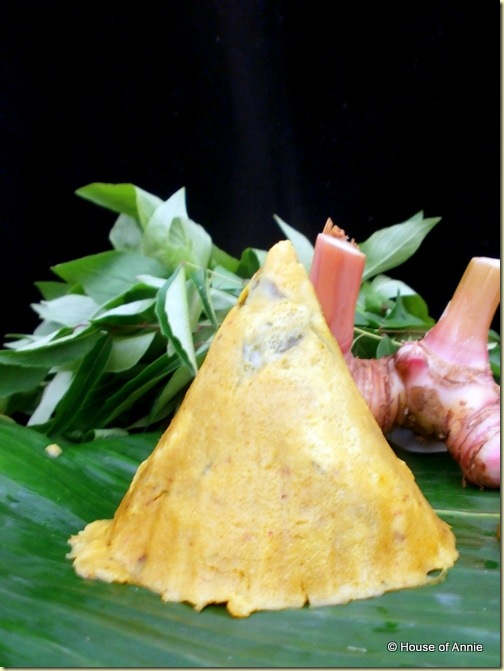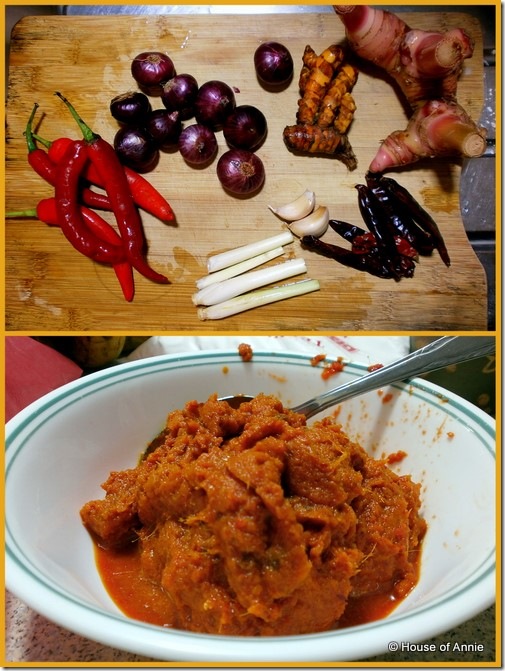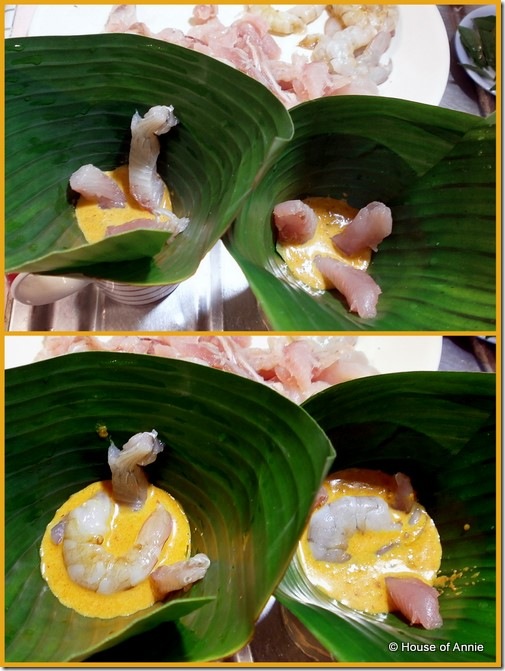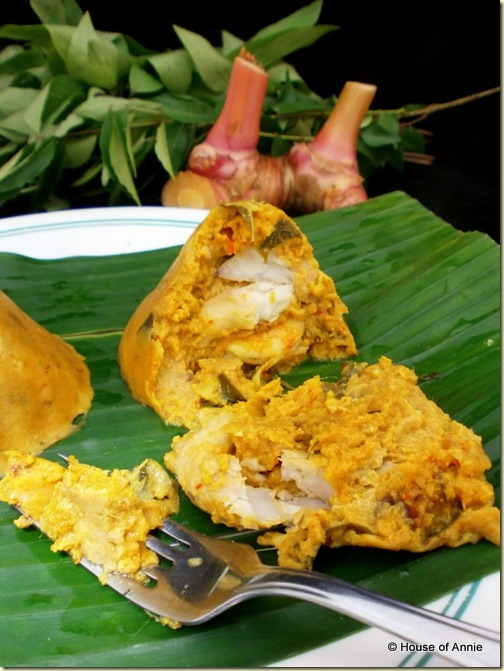Making this favorite Nyonya dish is easier with the Royal Selangor jelly moulds.
Today is the most time-pressed post yet. We started prepping for this dish at 8pm so please forgive us for the brevity as I am writing this under immense pressure to meet the Jellyriffic challenge midnight posting timeline. I think we’re pretty crazy to try something this ambitious so late especially when it’s our very first time making this as well.
But guess what? It took all of 1 hour to prep. Despite the number of ingredients, this dish actually comes together quite quickly especially if you have a blender at home or food processor to do all the hard work!
Improvisations
The only problem we faced with this dish is finding daun kadok (betelnut leaves). Believe it or not, when we went to the market this morning, I was absolutely confident we would be able to find it. Boy, was I surprised when I couldn’t AND when I asked around, all the vendors I asked just looked puzzled and had NO CLUE what I was asking for.
Nyonya food is not common here and almost all otak-otak I have found here, do not contain these kadok leaves. Oh well…I guess this just means that I will have to call for some improvisations.
So I went with some curry leaves and some Thai basil instead. Yes, I know it’s not the same but I believe these are complementary to the other spices found in this dish (and you know that Nate loves curry leaves!) so there we go!
Alright, on to the recipe…
Otak-Otak recipe
adapted from Nyonya Flavours
(makes 2 Royal Selangor moulds worth and about 8 more parcels)
Prep time: 1 hr 30 min / Total time: 2 hours 30 min
Ingredients
1 banana leaf
Custard ingredients
250ml (1 cup) thick coconut milk (from 1 grated coconut)
2 eggs, lightly beaten
2 Tbsp heaped rice flour
4 kaffir lime leaves, sliced finely
1/2 tsp white ground pepper
1 Tbsp sugar, or to taste
1 tsp salt, or to taste
Spice paste (ground)
100g (10) shallots
20g (2 cloves) garlic
40g (5) fresh red chillies, discard seeds
7g (6-8) dried red chillies, soaked and drained
15g (2cm) galangal
20g (2-3cm) fresh turmeric
40g (2-3 stalks) lemongrass, bottom 3 inches only
20g belachan, toasted
half a bunch thai basil leaves (original recipe called for 30 kadok leaves)
a couple of curry leaves per parcel
500g white fish fillet (we used tenggiri, a mackerel), deboned, and skinned, cut into slices
10 medium shrimp, shelled (optional)
Spice Paste for Otak-Otak
Method
1. Cut banana leaf into 18x20cm rectangles and steam or scald with hot water to soften the leaf. Fold two of these leaves to form a pointy end and place into RS moulds.
2. Combine the custard ingredients in a mixing bowl and add the spice paste. Mix well.
3. For the RS mouds: To assemble, places 4-5 Thai basil leaves on the bottom of the mould. Spoon in 2 Tbsp of the custard mixture and then place 3 slices of fish, top with another 2 Tbsp custard mixture. Place 1 shrimp and spoon more custard mixture on. Finally, add a couple of curry leaves and more Thai basil before covering to the top with more custard mixture. Cut out two banana leaf circles and cover top.
To make parcels: Place some Thai basil leaves in the center of a banana leaf rectangle. Top with 3 slices of fish and 2 Tbsp of the custard mixture. Form into a pyramid-shaped bundle by folding up both sides of the banana leaf to meet in the centre. Then fold up the two ends to meet in the centre and secure with bamboo toothpicks or staples.
4. Steam the ones in the moulds for until the custard is set and there is no more runny liquid that seeps out if you press down on the top (about 20-30 minutes) and the parcels for about 10 minutes over rapidly boiling water to set the custard. Serve with rice or bread.
Steaming the Otak-Otak
The Real Deal
This recipe is the real deal for Nyonya flavor! A really nice blend of spices that works terrifically together. And you know what? Making the otak-otak in the moulds is way easier than trying to fold those packets. The banana leaves kept breaking and leaking on us and it was hugely frustrating to try to seal them without it dripping custard all over the place.
So I recommend you purchase a couple of Royal Selangor Jelly Moulds to make your own otak-otak. You won’t regret it! Proceeds from the sale will go to support the Breast Cancer Welfare Association of Malaysia, plus you get to enter a chance to win an Olympus camera AND vote for your favorite blogger (hint, hint) to win the trip to KL. Click here for more details.
Enjoy!
Cheers, Annie
I am entering this post in the Cookbook Party in honor of National Seafood Month. Cookbook Party is hosted by Louise of the Months of Edible Creations blog.





Looks delicious!….daun kadok is not very common in Kuching or Sarawak for that matter. Locals do not include it in their everyday cooking, hence the reason why you can’t find it easily in the market. Those who often use or take it as ‘ulam’ would probably plant it themselves in their backyard. It used to be planted at my workplace but I am not sure if the plants are still there.
Hi Nate & Annie, Your dish is a most welcome addition to the Cookbook Party. I can’t believe how you just “threw” it all together under such duress. You did GREAT!!! I love the way you improvised too!!!
Thank you so much for sharing and GOOD Luck at the party!!!
Oh my gosh I LOVE otak-otak! GREAT recipe!
I have enjoyed your creativity! How about making sushi in those molds?
whoaa.. normally we have otak2 with all the fish meat blend together with the ingredient..but your is a big chunk..and you have otak2 udang aswell bEST!!!
It is interesting that what is called otak otak in Malaysia is completely different in Jakarta. As a matter of fact, in Indramayu, which is also in Indonesia, it is also different. In Jakarta, otak otak is a fish mixture with starch rolled in banana leaves and then roasted. The otak otak are (after peeled from the banana leaf package) small, between 1 1/2-2 cm wide and about 8 cm long. They are usually eaten with spicy peanut sauce. If you buy otak otak in Indramayu, you will get a steamed package. I do not know how they are made, but also use ground fish.
Very interesting structure and combination you came up with for your nonya style otak-otak. But from what I understand from the experts of nonya cooking, they say that if you can’t find the daun kaduk leaves, then don’t add them at all, because anything else could taste strange. Thai basil leaves and curry leaves are not the same taste as daun kaduk, no offence.
Thanks for sharing though! 🙂
i am a baba from Penang of malaysia I love this dish very very much now I am happy to have the recipe but to get daun kadok leaves not easy here
I’m trying for the first time. My kaduk plant dried up due to lack of water in pot. Your suggestion of basil leaves a good idea.